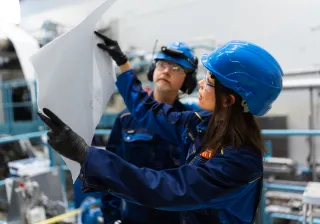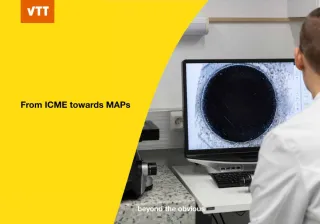The packaging industry needs to find more sustainable alternatives to fossil-based materials. In response to this challenge, VTT and Stora Enso developed an innovative barrier film for food packaging from microfibrillated cellulose.
Key facts
The packaging industry seeks to decrease its environmental footprint by finding alternatives for fossil-based food packaging.
Microfibrillated cellulose (MFC) is a versatile, 100% renewable wood fibre-based material that can be used, for example, as a sustainable barrier solution for liquid packaging, replacing aluminium and plastics.
VTT and Stora Enso demonstrated that MFC can be applied on a high-volume scale to a continuous production process.
Part of the global bioeconomy, Stora Enso is a leading provider of renewable products in packaging, biomaterials and wooden construction, and one of the largest private forest owners in the world. The company creates value with low-carbon and recyclable fibre-based products to support customers in meeting the demand for renewable sustainable products. Stora Enso has approximately 20,000 employees and their sales in 2023 were EUR 9.4 billion.

Multidisciplinary capabilities needed for novel process
A major development shaping the future of the packaging industry is the need to improve the recyclability and reduce the carbon footprint of food packaging. Under the EU packaging strategy and the SUP directive, all packaging in the EU should be reusable or recyclable in an economically viable way by 2030, and the use of single-use plastics will be limited. Replacing fossil-based raw materials in packaging – such as plastic films or aluminium foil – with natural, renewable, and biodegradable materials can significantly reduce the CO2 footprint of packaging.
We were especially impressed with VTT’s concrete technical suggestions and their way of focusing on industrial-level scalability and the bottlenecks in production that needed to be solved.
As one of the world’s main producers of liquid packaging board, and with extensive know-how in MFC, Stora Enso recognised the potential of producing a renewable MFC barrier film to replace aluminium in food packaging. Laboratory tests had shown that MFC can be used to produce a similar layer for protecting the contents, providing a barrier to oxygen. To further explore the qualities of the material and develop the production technology, Stora Enso originally contacted VTT in 2015 to provide ideas and a concept for manufacturing a barrier film from MFC.
“We needed a new type of multidisciplinary approach regarding the manufacturing technology, and VTT presented us with an interesting vision. We were especially impressed with VTT’s concrete technical suggestions and their way of focusing on industrial-level scalability and the bottlenecks in production that needed to be solved,” says Team Manager & Project leader Otto Nylén from Stora Enso Packaging Materials.
From laboratory to pilot
As a viscous shear thinning material, MFC is challenging to handle in a continuous process. MFC film – made from MFC and additives – is only around 0.02–0.03 millimetres thick and requires carefully controlled process steps for continuous production. In the first laboratory phase, VTT was able to present the material qualities of MFC that set certain technical preconditions for manufacturing, and how the material is handled in different steps, including mixing, pumping, and spreading to dry on a steel belt. VTT developed material recipes, technologies and measurement devices that demonstrated the viability of the process.

Taking the new manufacturing concept beyond the laboratory phase required investing in piloting capabilities. Discussions between Stora Enso and VTT led to a strategic partnership model, which enabled Stora Enso to purchase a development project from VTT, where VTT invested and modified pilot infrastructure in Jyväskylä, Finland, creating the new SAMPO pilot line. The pilot phase enabled demonstrating how the process can be upscaled in practice and that the material can be produced continuously. As a result, the world’s first high quality 700-metre barrier film reel was produced in November 2019.
According to VTT’s Principal Scientist Riku Pihko, developing a completely new product and production technology has extended VTT’s already deep expertise in MFC and production processes. By solving various technical challenges during the project, VTT now has an even better understanding of modelling, measuring, and manufacturing that can be applied also to other material processes.
“This project has further strengthened our ability to validate a novel material innovation and take it through the entire development path, from laboratory scale to the piloting phase, and demonstrate its technical viability to the customer,” Pihko notes.
A huge leap forward in MFC film production
During the R&D project, VTT provided Stora Enso with:
- Multidisciplinary expertise based on a deep understanding of the raw material.
- The development of new material recipes, production technologies, and measurement devices.
- An agile ecosystem of unique piloting and laboratory facilities.
- In total, tens of kilometres of MFC film produced.
According to Stora Enso’s Nylén, the greatest achievement of the R&D project was developing a functional product and production concept that can potentially be applied to other areas and segments. However, after the piloting phase, Stora Enso decided that the concept is not commercially viable at this point for their targeted business segment.

“This is not uncommon in innovation projects – and although we did not make an investment decision at this point – it doesn’t mean that the concept isn’t viable for other applications and operators. Fibre-based sustainable solutions continue to be one of the key R&D focus areas at Stora Enso, and we want to support and enable the further development of this MFC concept where possible,” Nylén concludes.
Jaakko Kuusisaari, Solution Sales Lead at VTT says that the development work is far from over, as the need for all types of sustainable packaging solutions is increasingly pressing, and upcoming regulation may still change the operating environment. Where the use of plastic in packaging is not an option, MFC film becomes a viable alternative.
“We have already taken a major leap forward by being able to demonstrate the upscaling of MFC film production. By combining our knowhow and best development practices, VTT can develop completely new products for customers, also in new business areas. Learnings from this project can well be applied to other product categories and segments in the future,” Kuusisaari says.









